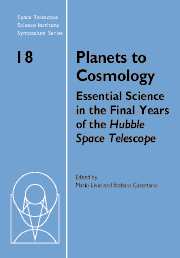 Planets to Cosmology
Planets to Cosmology Book contents
- Frontmatter
- Contents
- Participants
- Preface
- Hubble's view of transiting planets
- Unsolved problems in star formation
- Star formation in clusters
- HST abundance studies of low metallicity stars
- Physical conditions and feedback: HST studies of intense star-forming environments
- Quasar hosts: Growing up with monstrous middles
- Reverberation mapping of active galactic nuclei
- Feedback at high redshift
- The baryon content of the local intergalactic medium
- Hot baryons in supercluster filaments
- Galaxy assembly
- Probing the reionization history of the Universe
- Studying distant infrared-luminous galaxies with Spitzer and Hubble
- Galaxies at z ≈ 6–i′-drop selection and the GLARE Project
- The Hubble Ultra Deep Field with NICMOS
Hot baryons in supercluster filaments
Published online by Cambridge University Press: 17 August 2009
- Frontmatter
- Contents
- Participants
- Preface
- Hubble's view of transiting planets
- Unsolved problems in star formation
- Star formation in clusters
- HST abundance studies of low metallicity stars
- Physical conditions and feedback: HST studies of intense star-forming environments
- Quasar hosts: Growing up with monstrous middles
- Reverberation mapping of active galactic nuclei
- Feedback at high redshift
- The baryon content of the local intergalactic medium
- Hot baryons in supercluster filaments
- Galaxy assembly
- Probing the reionization history of the Universe
- Studying distant infrared-luminous galaxies with Spitzer and Hubble
- Galaxies at z ≈ 6–i′-drop selection and the GLARE Project
- The Hubble Ultra Deep Field with NICMOS
Summary
Most of the baryons in the local universe are “missing” in that they are not in galaxies or in the previously detected gaseous phases. These missing baryons are predicted to be in a moderately hot phase, 105–107 K, largely in the form of giant cosmic filaments that connect the denser virialized clusters and groups of galaxies. Models show that the highest covering fraction of such filaments occurs in superclusters. To determine whether such filaments exist, we have begun a project to search for UV absorption against AGNs projected behind possible supercluster filaments. Using data from the HST and FUSE archives along with new observations, we have detected UV absorption within about 1300 km s−1 of seven supercluster sightlines out of a sample of eight. The likelihood of such detections being generated by chance is less than 10−4.
Introduction
A census of baryons in the local universe indicates that the majority of this normal matter is undetected, or “missing.” At high redshifts (z ∼ 3), big-bang nucleosynthesis models and QSO absorption line observations indicate a baryon mass fraction of Ωb ∼ 0.04 (e.g., Fukugita, Hogan & Peebles 1998). The stars and gas detected in local galaxies account for only 20% of this (Ωb ∼ 0.008). The absence of a local Lyα forest indicates that these baryons are likely in a hot (T > 105 K), diffuse medium which has heretofore remained undetectable (e.g., Fukugita, Hogan & Peebles 1998; Cen & Ostriker 1999a; Davé et al. 2001).
- Type
- Chapter
- Information
- Planets to CosmologyEssential Science in the Final Years of the Hubble Space Telescope: Proceedings of the Space Telescope Science Institute Symposium, Held in Baltimore, Maryland May 3–6, 2004, pp. 130 - 136Publisher: Cambridge University PressPrint publication year: 2006


